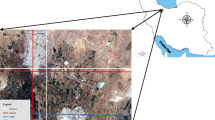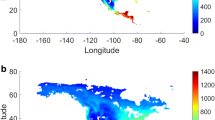Abstract
Evapotranspiration (ET) is a major factor in the water cycle that is most directly affected by land use and climate change. The accurate estimation of the daily ET is an important link in the study of its hydrological and ecological interaction, hydrological cycle, and oasis ecosystem management in arid and semi-arid regions. Considering astronomical, atmospheric (i.e., air molecules, water vapor, and cloud), and surface factors (i.e., slope, aspect, terrain shading, and surface coverage), the new daily global solar radiation (GSR)model is proposed, based on Iqbal model C, DEM, TM, and MODIS data. The new model has been coupled with SEBAL to better estimate ET. The daily surface ET of June 21–24, 2009, in Heihe River Basin is simulated. The results are as follows: (1) the improved daily GSR mean absolute bias error (MABE) is 9 W/m2, and the mean absolute relative bias error (MARBE) is 2.5%. The MABE of the daily GSR using the SEBAL model is 122.2 W/m2, and the MARBE is 33.9%. (2) The improved SEBAL MABE of farmland ET decreases from 2.1 mm (original scheme) to 0.6 mm (improved scheme), and the MARBE declines from 44 to 13% accordingly. Moreover, the spatiotemporal resolution of the ET simulation is effectively improved by the TM/MODIS hybrid strategy. (3) All highest ET value appeared in all types of water bodies, followed by farmland, forest, wetland, and residential areas, and the lowest values appeared over bare rock land. The new results provide better theoretical basis and scientific guidance for ecosystem protection and sustainable utilization of water resources.





Similar content being viewed by others
Change history
08 May 2024
A Correction to this paper has been published: https://doi.org/10.1007/s00704-024-04986-8
References
Ahmad MD, Kirby M, Islam MS et al (2014) Groundwater use for irrigation and its productivity: status and opportunities for crop intensification for food security in Bangladesh. Water Resour Manag 28(5):1415–1429
Bastiaanssen WGM, Menenti M, Feddes RA, Holtslag AAM (1998a) The Surface Energy Balance Algorithm for Land (SEBAL): part 1 formulation. J Hydrol 212-213:198–212
Bastiaanssen WGM, Pelgrum H, Wang J, Ma Y, Moreno J, Roerink GJ, van der Wal T (1998b) A remote sensing Surface Energy Balance Algorithm for Land (SEBAL): part 2 validation. J Hydrol 212-213:213–229
Bastiaanssen WGM (2000) SEBAL-based sensible and latent heat fluxes in the irrigated Gediz Basin, Turkey[J]. J Hydrology 229:87–100
Brutsaert W, Sugita M (1992) Application of self-preservation in the diurnal evolution of the surface energy budget to determine daily evaporation. J Geophys Res Atmos 97:18377–18382
Chen X, Su Z, Ma Y, Yang K, Wang B (2013) Estimation of surface energy fluxes under complex terrain of Mt. Qomolangma over the Tibetan Plateau. Hydrol Earth Syst Sci 17:1607–1618
Crago RD (1996) Conservation and variability of the evaporative fraction during the daytime. J Hydrol 180:173–194
Iqbal M (1983) An introduction to solar radiation. Academic Press, p 390
Kite GW (2000) Using a basin-scale hydrological model to estimate crop transpiration and soil evaporation. J Hydrol 229:59–69
Kasten F, Young AT (1989) Revised optical air mass tables and approximation formula. Appl Opt 28:4735–4738
Li SB, Zhao WZ (2010) Satellite-based actual evapotranspiration estimation in the middle reach of the Heihe River Basin using the SEBAL method. Hydrol Process 24:3337–3344
Li SB (2009) Regional evapotranspiration of desert oasis in middle reach of the Heihe River. Phd. thesis. Cold and Arid Region Environmental and Engineering Research Institute,Chinese Academy of Sciences
Liu CS (2008) Regional land surface water/heat flux modeling and application based on remote sensing in Shandong Province. Phd. thesis,. Nanjing University of Information Science & Technology
Morse A, Tasumi M, Allen RG, Kramber WJ (2000) Application of the SEBAL methodology for estimating consumptive use of water and streamflow depletion in the Bear River Basin of Idaho through Remote Sensing. In: Final Report Submitted to The Raytheon Systems Company Earth Observation System Data and Information System Project
Nie ZL (2004) Study on groundwater circulation and renewability in the Middle Reaehes of Heihe River Valley,Northwest China. Phd. thesis,. Chinese Academy of Geological Sciences
Pan Z, Liu G (2003) Dynamic analysis of evapotranspiration based on remote sensing in Yellow River Delta. J Geogr Sci 13(4):408–415
Qiu XF (2003) Distributed modeling of solar radiation over rugged terrains. Phd. thesis,. Nanjing University
Shuttleworth WJ, Gurney RJ, Hsu AY, Ormsby JP (1989) FIFE:The variation in energy partition at surface flux sites. In: Rango A (ed) Remote sensing and large-scale processes (Proceeding of the IAHS third internation Assembly,Baltimore,MD,May,1989), vol 186:66-74. IAHS Publication
Shi GP, Qiu XF, Zeng Y (2018) New method for estimating daily global solar radiation over sloped topography in China. Adv Atmos Sci 35(3):285–295
Teixeira AH d C, WGM B, Ahmad MD, Bos MG (2009) Reviewing SEBAL input parameters for assessing evapotranspiration and water productivity for the low-middle Sao Francisco river basin, Brazil Part A: Calibration and validation. Agric For Meteorol 149:462–476
Thoms K, Van H (1979) Estmating atmospheric ozone for solor radiation models. Solor Energy 22:63–68
Usman M, Liedl R, Awan UK (2015) Spatio-temporal estimation of consumptive water use for assessment of irrigation system performance and management of water resources in irrigated Indus Basin, Pakistan. J Hydrol 525:26–41
Xia T, Wang Z (2013) Sensitivity re-analysis of SEBAL to input data. J Tsinghua Univ 53(9):1241–1248
Yin JQ (2014) Study on daily evapotranspiration estimation model by remote sensing coupling daily global solar radiation model and daily mean LST model. Phd. thesis,. Nanjing University of Information Science & Technology
Yeom JM, Seo YK, Kim DS, Han KS (2016) Solar radiation received by slopes using COMS imagery, a physically based radiation model, and GLOBE. J Sens 4834579:1–15
Zeng Y, Qiu XF, Liu SM (2005) Distributed modeling of extraterrestrial solar radiation over rugged terrains. Chin J Geophys 48(5):1028–1033
Zheng CL, Wang Q, Li PH (2016) Coupling SEBAL with a new radiation module and MODIS products for better estimation of evapotranspiration. Hydrol Sci J 61(8):1535–1547
Acknowledgements
This study is supported by the 2022 Project of the Innovation and Entrepreneurship Training Plan for College Students in Jiangsu Province (202213982031Y,202213982013Y) and National Natural Science Foundation of China (41871285, 41771415, 41805083).
Author information
Authors and Affiliations
Contributions
Jingqiu Yin and Xinfa Qiu conceived this study and performed the data analysis and wrote the manuscript. All the other authors are actively involved in the discussions.
Corresponding author
Ethics declarations
Conflict of interest
The authors declare no competing interests.
Additional information
Publisher’s Note
Springer Nature remains neutral with regard to jurisdictional claims in published maps and institutional affiliations.
The original online version of this article was revised: The author’s name Hanwei Wu was incorrectly written as Haiwei Wu.
Rights and permissions
Springer Nature or its licensor (e.g. a society or other partner) holds exclusive rights to this article under a publishing agreement with the author(s) or other rightsholder(s); author self-archiving of the accepted manuscript version of this article is solely governed by the terms of such publishing agreement and applicable law.
About this article
Cite this article
Yin, J., Qiu, X., Li, S. et al. Estimation of evapotranspiration through an improved daily global solar radiation in SEBAL model: a case study of the middle Heihe River Basin. Theor Appl Climatol 155, 3163–3174 (2024). https://doi.org/10.1007/s00704-023-04796-4
Received:
Accepted:
Published:
Issue Date:
DOI: https://doi.org/10.1007/s00704-023-04796-4




